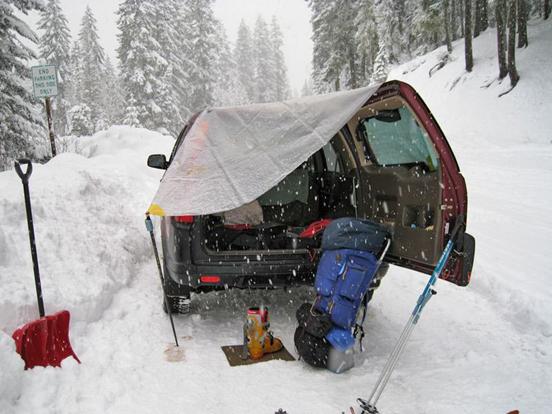Drying outer layers in a tentÖ.in the winterThis was written as part of a trip report for Turns All Year: Note: a related article on ski camping with Raynaudís is here.
After quite a bit of trial and error, I haven't changed what follows that much over the last 2 years, so I'm reasonably happy with it. This may all be common knowledge;† ó oh well.
Starting out: Starting out dry is a big plus, but it's all too easy to get quite wet just getting out of the car and getting the gear ready to go. Here's a fairly easy solution as shown in the picture below. I originally used something like this over the driver side door of my old 2 door Honda Accord. It's a 6 x 9 foot piece of 4 mil plastic with a cord through a pocket along one edge. The cord has little hooks that catch under the wheel wells. There are grommets on the two opposite corners, one of which has a loop of shock cord to attach to the door. The other grommet is used to locate an old ski pole shaft so that a little tent is created.
Besides getting ready to go out of the rain or snow, you can also cool the skis down before you put them right from a warm car into the snow and risk icing up. And when you get back to the car in the midst of a snow or rain storm, it's a delight to be able to take off wet gear and pack up without getting further soaked.
|

|
Drying out in the tent: Even if you start out dry, when it's snowing or raining heavily your outer layers will get wet, even soaking wet inside and out depending on how far you go and how hard you work. Carrying a winter pack requires a lot of extra energy, and generates a lot more sweat. Once the parka is covered with wet snow or rain, it does not breathe much† if at all. The latest Gore-Tex will not solve this problem.
When you expect the skiing to be good the next day, having dry pants and parka make the difference between enjoyment and just tolerating the conditions. Although temps while it's snowing east of the Cascade crest are often near freezing and thus a setup for getting everything wet, once the front passes and it clears off, it can cool off very rapidly. This week for example, at my 3100 ft camp it was 29 degrees and snowing heavily when I arrived. During the night it cleared off and the temp dropped to a low of 17 degrees. If I were on the other side of the valley, and heading towards Jolly, the temps could easily have been in the low teens further up. Starting out before dawn with a wet and now frozen parka just sucks the heat right out. Only for the young I guess.
Here's how I dry out the outer layers: when I'm ready to get into the tent, I brush the snow off my pants with home made snow brush, then swab off any excess water with an absorbent towel. I've tried quite a few different types, and by far the best are Kimberly Clark Wypall automotive shop towels. They are hard to find, but well worth it for summer as well as winter use.
Then I take the parka off, shake it out quickly, briefly swab the outside to remove water droplets and then bunch it up and toss it in the tent where it will not get anything else wet. (See the addendum at the end of this article for a better way.) Then I duck into the tent, hopefully not having gotten the intermediate layer that wet in the process.
The next step is to get organized inside the tent and get the stove running. Running a stove inside the tent makes a huge difference in how much moisture you can get rid of, but it is very dangerous. It's perhaps as risky as skiing on avalanche prone slopes. My only advice would be that if you don't already do this, and know exactly what you are doing, don't start based on reading this material.
Once you have some heat going you can strip to your base layers and start allowing them to dry. It takes forever if they are covered with another layer. Don't put the sleeping bag out yet; It will only get wet at this point.
|
|
More warning about running a stove in a tent: To give an idea of how careful I try to be, hereís part of my routine: Iím meticulous about stove maintenance; I disassemble and clean it every 4 to 6 trips† (once a month or so) in the winter. I check all parts of the stove. I know the stove well; Iíve been using the same one since† the mid 70s. And I use it a lot! Every week year round, always in the tent. I have a usage pattern that I always follow and never change. I never trust seals. I think of running a stove in a tent in the same category as using a propane stove on a sailboat; it takes just one mistake to kill you.† There is more, but thatís enough for now. Larry † |
